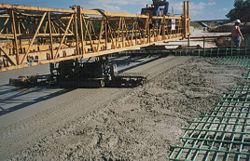Category:505 Bridge Deck Concrete Wearing Surface
| Bridge Deck Mixes, Laboratory Testing |
| Report 2003 |
| Summary 2003 |
| Bridge Deck, Overlay, Latex |
| Summary 2006 |
| Report 2006 |
| Latex Modified Concrete Best Practices Tutorial (pdf file) |
| See also: Innovation Library |
Contents
505.1 Construction Inspection (for Sec 505)
505.1.1 Low Slump Concrete (for Sec 505.10)
This wearing surface is designed to prevent the intrusion of water and salt to the reinforcing steel thus slowing the rusting process. It is, therefore, very important that the surface be finished properly. The pour should be planned to minimize the combined effect of hot atmospheric temperatures, low humidity, hot concrete temperatures, high winds and dusty conditions. Even if all are individually within specifications, a combination of these conditions can cause rapid drying of the surface resulting in tearing or cracking. If the deck cannot be sealed properly, the pour should be stopped.
505.1.1.1 Description (for Sec 505.10.1)
A low slump concrete wearing surface is sometimes specified for structure work. This work consists of placing a dense low slump overlay on a prepared surface of either an existing concrete deck on a new structure.
505.1.1.2 Material (for Sec 505.10.2)
505.1.1.3 Concrete Mixture (for Sec 505.10.3)
(Sec 505.10.3.1) The contractor shall submit a mix design mix to District Materials meeting the low slump concrete specifications for review and approval. Representative samples may need to be sent to Construction and Materials for laboratory testing.
505.1.1.4 Testing (for Sec 505.10.4)
(Sec 505.10.4.1) See Consistency
(Sec 505.10.4.2) See Air-Entrained Concrete
(Sec 505.10.4.6) Refer to MoDOT Test Method TM 36.
505.1.1.5 Finishing Equipment (for Sec 505.10.7)
(Sec 505.10.7.1) It is important for the finishing machine to be in proper adjustment so that very little hand work is necessary to seal the surface.
505.1.2 Latex Modified Concrete (Sec 505.20)
| Bridge Deck, Overlay, Latex |
| Summary 2006 |
| Report 2006 |
| Latex Modified Concrete Best Practices Tutorial (pdf file) |
| Latex Modified Concrete Best Practices Tutorial (PowerPoint file) |
| See also: Innovation Library |
This wearing surface is designed to prevent the intrusion of water and salt to the reinforcing steel thus slowing the rusting process. It is, therefore, very important that the surface be finished properly. The pour should be planned to minimize the combined effect of hot atmospheric temperatures, low humidity, hot concrete temperatures, high winds and dusty conditions. Even if all are individually within specifications, a combination of these conditions can cause rapid drying of the surface resulting in tearing or cracking. If the deck cannot be sealed properly, the pour should be stopped.
505.1.2.1 Description (for Sec 505.20.1)
A latex modified concrete wearing surface is sometimes specified for structure work. This work consists of placing a dense low slump overlay on a prepared surface of either an existing concrete deck on a new structure.
505.1.2.2 Concrete Mixture (for Sec 505.20.3)
(Sec 505.20.3.1) The contractor shall submit a mix design mix to District Materials meeting the latex modified concrete specifications for review and approval. Representative samples may need to be sent to Construction and Materials for laboratory testing.
505.1.2.3 Mixing (for Sec 505.20.5)
(Sec 505.20.5.1) See Volumetric Batched and Continuous Mixed Concrete.
505.1.2.4 Finishing Equipment (for Sec 505.20.7)
(Sec 505.20.7.1) It is important for the finishing machine to be in proper adjustment so that very little hand work is necessary to seal the surface.
505.1.3 Silica Fume Concrete (for Sec 505.30)
This wearing surface is designed to prevent the intrusion of water and salt to the reinforcing steel thus slowing the rusting process. It is, therefore, very important that the surface be finished properly. The pour should be planned to minimize the combined effect of hot atmospheric temperatures, low humidity, hot concrete temperatures, high winds and dusty conditions. Even if all are individually within specifications, a combination of these conditions can cause rapid drying of the surface resulting in tearing or cracking. If the deck cannot be sealed properly, the pour should be stopped.
505.1.3.1 Description (for Sec 505.30.1)
A silica fume concrete wearing surface is sometimes specified for structure work. This work consists of placing a dense low slump overlay on a prepared surface of either an existing concrete deck on a new structure.
505.1.3.2 Concrete Mixture (for Sec 505.30.3)
(Sec 505.30.3.1) The contractor shall submit a mix design mix to District Materials meeting the silica fume concrete specifications for review and approval. Representative samples may need to be sent to Construction and Materials for laboratory testing.
505.1.3.3 Finishing Equipment (for Sec 505.30.7)
It is important for the finishing machine to be in proper adjustment so that very little hand work is necessary to seal the surface.
505.1.4 Polyester Polymer Concrete (PPC)
Polyester polymer concrete (PPC) is a polyester-based polymer overlay and patching system designed for the rapid repair and rehabilitation of Portland cement concrete (PCC) bridge decks. It achieves over 4,000 psi in 24 hours. This very durable product has been successfully used since the 1980s in other states. It is not prone to cracking and is a good product to protect the existing deck from chlorides. PCC is more expensive than other overlays. It is applied by a special paver and aggregates must be shipped in.
505.2 Materials Inspection (for Sec 505)
505.2.1 Scope
This article establishes procedures for inspecting and reporting admixtures for use in Bridge Deck Concrete Wearing Surfaces.
505.2.2 Procedure
505.2.2.1 Silica Fume Admixture
A qualified list of silica fume admixtures is available. If an admixture is proposed for use and does not appear in the qualified list, the State Construction and Materials Engineer is to be notified to obtain procedures for qualification.
505.2.3 Acceptance
Acceptance of admixtures is based on brand name approval, correct certification and information as required by specifications and any tests deemed necessary.
505.2.4 Sample Record
Silica fume admixtures are to be reported through SiteManager.
